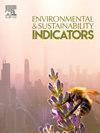Satellite-based assessment of Phenological Informatics and associated drivers over a biodiversity hotspot in the North Eastern Region of India
IF 5.4
Q1 ENVIRONMENTAL SCIENCES
引用次数: 0
Abstract
This study provides a comprehensive assessment of phenological dynamics in the ecologically diverse North Eastern Region (NER) of India (255,083 km2) using MODIS EVI data (2001–2020). We identified 11 climate-induced phenological shift scenarios, comprising eight translational (TS) and three scaling (SS) shifts, and analyzed their key climatic drivers using machine learning. Results indicate an overall advancement in the Start of Growth (SOG) by 0.50 days/year and a delay in the End of Senescence (EOS) by 0.95 days/year, extending the growing season by approximately 0.8 days/year. The most widespread shift, TS4 (delayed EOS, unchanged SOG), affects 12.83 % of NER's forests, while occurrence of TS7 (advancing SOG, delaying EOS) and TS8 (delaying SOG, advancing EOS) highlight forest adaptation to climate variability. Translational shifts predominantly occur below 600m, particularly in moist deciduous (27.57 %) and subtropical broadleaved (24.54 %) forests. Scaling shifts reveal that SS3 (no change in growth rhythm) dominates 36.36 % of the region, while SS1 (increased vigor) accounts for 23.67 %. Climate analysis identifies rainfall (100 %), solar radiation (91.97 %), soil moisture (90.37 %), and vapor pressure deficit (VPD) as key phenology drivers. Land surface temperature and VPD primarily trigger greening in most translational scenarios, while VPD and solar radiation are key factors in senescence. Rainfall is the dominant factor in scaling scenarios. These findings provide crucial insights into climate-phenology interactions in NER, aiding ecosystem management and adaptation strategies for climate resilience.
印度东北地区生物多样性热点物候信息学及其相关驱动因素的卫星评估
本研究利用MODIS EVI数据(2001-2020年)对生态多样化的印度东北地区(NER) (255,083 km2)物候动态进行了综合评估。我们确定了11种气候引起的物候变化情景,包括8种平移(TS)和3种尺度(SS)变化,并利用机器学习分析了它们的关键气候驱动因素。结果表明,生长开始(SOG)总体提前了0.50天/年,衰老结束(EOS)延迟了0.95天/年,生长季节延长了约0.8天/年。最广泛的TS4(延迟EOS,不变SOG)影响了12.83%的NER森林,而TS7(提前SOG,延迟EOS)和TS8(延迟SOG,提前EOS)的发生突出了森林对气候变率的适应。平动变化主要发生在600米以下,特别是在潮湿落叶林(27.57%)和亚热带阔叶林(24.54%)。尺度变化表明,SS3(生长节奏不变)占36.36%,SS1(活力增加)占23.67%。气候分析表明,降雨(100%)、太阳辐射(91.97%)、土壤湿度(90.37%)和蒸汽压亏缺(VPD)是主要物候驱动因素。在大多数平动情景中,地表温度和VPD是引发绿化的主要因素,而VPD和太阳辐射是导致衰老的关键因素。降雨是尺度情景中的主要因素。这些发现为研究东北沿海地区的气候物候相互作用提供了重要见解,有助于生态系统管理和气候适应策略。
本文章由计算机程序翻译,如有差异,请以英文原文为准。
求助全文
约1分钟内获得全文
求助全文
来源期刊

Environmental and Sustainability Indicators
Environmental Science-Environmental Science (miscellaneous)
CiteScore
7.80
自引率
2.30%
发文量
49
审稿时长
57 days
 求助内容:
求助内容: 应助结果提醒方式:
应助结果提醒方式:


